
Published on:

Go-ahead in Hanover-Lahe: Municipal energy service provider enercity has officially commissioned the sewage sludge mono-incineration plant designed and built by WTE as part of the sludge2energy (S2E) joint venture.
The ultra-modern plant in Hanover’s Lahe district is the first mono-incineration plant to feed into a municipal heating network. The plant can thermally utilise around 130,000 tons of dewatered sewage sludge per year and generate up to 56 million kilowatt hours of district heating in this way – a valuable contribution to the climate-friendly supply of the regional district heating network. The district heating generated covers the annual requirements of up to 15,000 customers in the enercity supply area.
But that’s not all: the plant also enables the recovery of the phosphorus contained in sewage sludge, which will be required by law from 2029. Phosphorus is a valuable raw material that is needed in fertilisers, for example.
In addition, the sewage sludge incineration plant has a particularly efficient flue gas cleaning system, which means that the emission values are significantly below the legal limits.
Overall, the new plant offers environmental protection engineering and energy efficiency at the highest level in order to enable our customer enercity to provide a future-proof disposal method for sewage sludge. At the same time, the plant will be a long-term benefit for the environment and represents a milestone for green district heating in the city of Hanover.
02/05/2024
Award for our wastewater treatment plant in Kočani: Médaille d'eau for energy efficiency and environmental friendliness04/21/2021
Milestone reached at Halle-Lochau sewage sludge incineration plant02/05/2024
Contract for the new pioneering project in North Macedonia signed in April 202302/05/2024
Tubli project - another milestone set in record time01/10/2024
WTE further expands its pioneering role in thermal sewage sludge utilisation: contract signed for new large-scale plant in Munich01/22/2024
Successful commissioning of the new plant in Umm Al Hayman